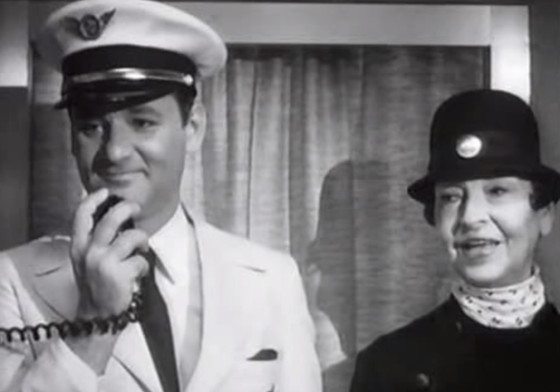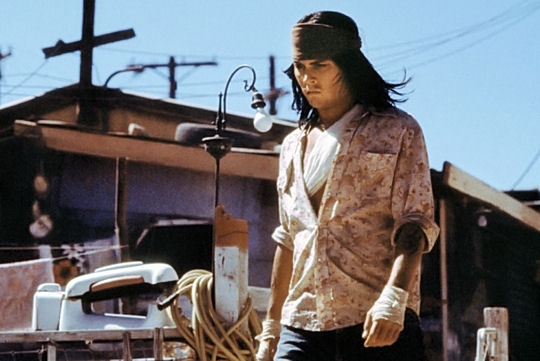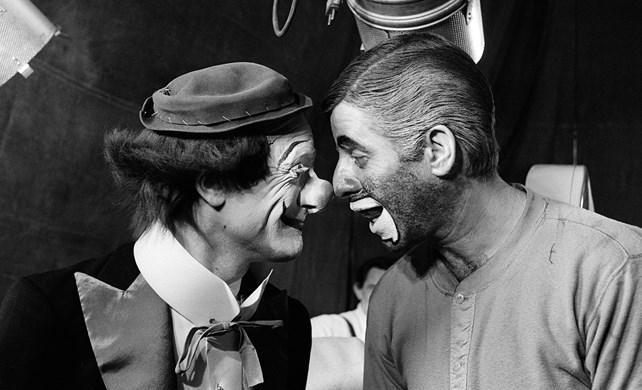5. Cocksucker Blues (1972)

The Film in Question: After the Rolling Stones 1969 concert debacle where a fan was stabbed to death by security – all charted in the excellent documentary “Gimme Shelter” (1970) – the Stones stepped out of the limelight in the States due to public backlash. Yet ,with the release of their “Exile on Main Street” album, they went back on tour and still photographer Robert Frank was paid to film the entire event.
This provided the the added bonus of making cameras available to the Stones entourage to do whatever the hell they wanted to with them, and they definitely did, with plenty of backstage drug use (e.g. Mick Jagger snorting coke, a groupie doing heroin) and sex (an airplane-set display of groupie love). This led to hours upon hours of footage following the craziness that followed the popular Brits on their comeback tour.
What Happened? The band got cold feet. They had commissioned Frank to make the film, but found the result embarrassing and incriminating, and even took him to court to prevent its release, which stopped the completed documentary dead in its tracks.
Is It Really Lost? The court decided on a bizarre ruling regarding allowing the film to be screened, yet only if Frank was present. Since then, it has been shown several times over the years at festivals and Rolling Stones retrospectives, but it will still never get a proper and official release on a media platform.
Was it Supposed To Be Any Good? It’s messy and indulgent, but for fans of the Stones and the 70’s music scene in general, it makes for an interesting watch. There’s a ‘fly-on-the-wall’ energy to it, where it captures the behind-the-scenes chaos in a completely unfiltered manner, leading to a fascinating insight to that era’s music scene, even though it tends to be hijacked by the weird circus that followed the group instead of the group itself.
4. Nothing Lasts Forever (1984)

The Film in Question: Tom Schiller was part of the original 1975 “Saturday Night Live” writing crew, and the director of some of the most standout and unique sketches on that show.
With his strong credentials backing him up, he landed his first feature project – a wacky and unique musical/sci-fi/comedy with SNL alumni Bill Murray and Dan Aykroyd taking small parts, Lorne Michaels producing, and Zach Galligan, the popular yet terminally inoffensive lead of the “Gremlins” and “Waxworks” franchises, as the main protagonist – a young, clueless pianist who sets off on the troublesome road to becoming a proper artist and ends up on a bus to the moon (don’t ask).
What Happened? The film was done and dusted off and ready for release, and then MGM did one test screening and pulled the plug on the movie, letting it rust on its back shelves for decades. Schiller has gone on the record saying he’s never received a clear answer about the studio’s reasoning for doing this, but blames it most likely on the post-Heaven’s Gate climate that had studios backtracking on risky ventures for fear of going under.
Is It Really Lost? It’s never seen any form of theatrical or home media release, despite adamant support from Murray and Aykroyd. However, over the years it has been shown on TV networks in Europe, and eventually on TCM in the US.
Was it Supposed To Be Any Good? Most definitely. Schiller lovingly recreates the film’s retro 40’s feel with a confident handle on its eccentric style with gorgeous photography and production value. Also, the wacky story displays lots laughs and enjoyable twists. Murray is great in a rare villain role, but Galligan’s vanilla flavor as an actor actually manages to hold the film’s craziness together, with his era-appropriate ‘gee shucks’ attitude and game pathos to take on whatever nutty scenario Schiller throws at him.
It’s a grand shame this film never saw a DVD release in the format’s explosion in the early 2000s, since it would’ve finally given the movie the necessary venue to grab its assured cult status. Certainly, its bizarreness might not be everyone’s cup of tea, but for those in the mood for a offbeat and expertly made 80’s comedy mash-up, look no further.
3. Dark Blood (1993) & (2012)

The Film in Question: In 1993, Dutch director George Sluizer, known for his film “Spoorloos” (1988), was in the midst of making his intriguing big American debut – a moody, dark thriller set in the Utah wasteland featuring the talented River Phoenix, as an oddball desert dweller who harasses a Hollywood couple, played by Judy Davis and Jonathan Pryce.
What Happened? According to Pryce, the production was already a nightmare due to the rough location conditions and on-set turmoil (supposedly Phoenix and Davis hated each other). Yet, the ultimate blow was struck when Phoenix died from a drug overdose with three weeks worth of scenes still left to film with him.
Spirits were crushed from his loss, and understandably put the movie into turnaround, with the decision that there was no possible way to complete what was left of the film into any semblance of a coherent story. It was left by the wayside – an obscure final note in Phoenix’s tragically short acting career.
Is It Really Lost? Simply said, yes it is. Without the chance to film Phoenix’s leftover scenes, the intended film will never be finished. Yet, interestingly enough, unlike the other films on this list, this one saw an official release on VOD in 2012.
After Sluizer grew ill in the beginning of the 2000s, he made it his mission to complete a version of the film for his viewers. This resulted in him stealing negatives from insurance holders, jumping on crowd-funding, and adding his voice-over to glue together the missing pieces of the film. Amazingly enough, he managed to get the film out before his death in 2014, and it remains his final legacy in a varied career.
Was it Supposed To Be Any Good? In the video introduction to Sluizer’s retooled version, the Dutch filmmaker quite clearly states that the final result is a “three-legged chair,” a product that will never be complete but can at least stand upright on it’s own; that’s an informative assessment of the film overall, and it makes for an intriguing yet wobbly watch that’s quite rough and disjointed.
Still, it’s fascinating for seeing Phoenix’s final work and his first ever villain role – he shows a penchant for slow-burn menace coupled with his reliable charisma, also Davis and Pryce are solid in their roles, as expected.
However, the film, regardless of the life thrown against it, just has an average plot – WASPy Americans having their mettle tested by disturbed country folk, and we’ve seen it before and done better.
The twists and turns just don’t connect much, although it’s not fair to criticize it so harshly since a handful of key scenes, which might’ve made us invest in our protagonists and their plights, were never filmed. With that said, what we’re left with is an interesting product for curious film buffs and Phoenix completionists – but the casual viewer will be left scratching their head.
2. The Brave (1997)

The Film in Question: In the mid-90s, Johnny Depp had successfully managed to shed his early teen idol status in a series of compelling lead roles.
This led to him having the chance to direct his first feature film (in which he also co-wrote and starred in), based off of the Gregory McDonald novel, where a poverty-stricken Native American (Depp) takes up an offer to star as the victim of a snuff movie. The large monetary sum awarded to him would go to his loving family, to help them move out of the (literal) rubbish heap in which they dwelled.
What Happened? Critical buzz aplenty hyped up the film due to the story’s arresting concept and Depp’s popularity at the time, but a screening at the Cannes Film Festival had a violently hateful reception from American critics, where it was written off as a disastrous ego venture from the talented star.
The film was thrown into turmoil for a good amount of years, with Depp refusing to ever officially release it in the States, due to his anger toward the press and critics. Never receiving a proper cinematic release, the film quickly fell out of sight, then out of mind.
Is It Really Lost? Not really – outside of the US, that is. Years after the infamous Cannes screening, it received a quiet and limited DVD release internationally, yet the film remains all but forgotten and swept under the rug due to the sour reputation it had been served. Depp never speaks about the film, and has never flirted with directing since then.
Was it Supposed To Be Any Good? It’s a heartfelt if flawed mood piece. Depp is surprisingly bland in the lead role, but behind the camera, he displays a keen visual eye and an ease at getting fine performances from a colorful cast (including a small supporting role by close friend Marlon Brando).
Sure, the pacing is lumbering (a major Cannes criticism), but it helps build a rich, doom-laden atmosphere, and while it doesn’t pay off its dense themes and ideas, there’s no denying that there’s a genuine beating heart underneath proceedings that result in a haunting quality. It doesn’t succeed on all of its terms, but it definitely deserved a lot better than what it received.
1. The Day the Clown Cried (1972)

The Film in Question: Jerry Lewis had the desire to take his successful comedy career in a more serious and dramatic direction by tackling an original script based around a German clown (Lewis) during the Holocaust, who amuses and comforts children being led to the gas chambers. It was a passion project for Lewis who wrote, starred, and directed the whole ordeal.
What Happened? A tumultuous production with financial troubles were already hurting the movie during production, but a ton of legal issues between the producers and Lewis hit the film hard during post-production, tying it up in an endless puzzle of litigation that prevented its release.
However, according to Lewis, it’s never seen the light of day due to his own persistence – he’s gone on record claiming the film was “bad, bad, bad” and that he was in over his head with the subject matter, never wishing for anyone to ever witness the human trainwreck that resulted as the final product.
Is It Really Lost? Most likely, yes. Lewis’ unbreakable stance on its release is one thing, but the amount of rights and written contracts that are bound up in a giant mess is another issue altogether. Still, word is that in 2015, Lewis himself handed the negative into the Library of Congress with the agreement that they won’t show it until 10 years have lapsed. So, watch this space in 2025…
Was it Supposed To Be Any Good? According to Lewis, definitely not. The only other feedback that has emerged over the years is, out of all people, from comedian Harry Shearer – he called it a glorious car crash of cinematic proportions, and a film so misguided and tonally awkward that it resulted in a masterpiece.
While the end product is hardly a lost piece of art, it still sounds fascinating – a documentary made a couple of years back, with released insane clips of behind-the-scenes footage with Lewis having an on-set meltdown whilst in blackface. Sounds like a fascinating watch, no?